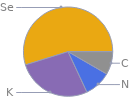Input interpretation

potassium selenocyanate | elemental composition
Result

Find the elemental composition for potassium selenocyanate in terms of the atom and mass percents: atom percent = N_i/N_atoms × 100% mass percent = (N_im_i)/m × 100% Plan: • Write the chemical formula and gather atomic masses from the periodic table. • Determine values for N_i, m_i, N_atoms and m using these items. • Finally, compute the percents and check the results. Write the chemical formula: KSeCN Use the chemical formula to count the number of atoms, N_i, for each element and find the total number of atoms, N_atoms, per molecule: | number of atoms C (carbon) | 1 K (potassium) | 1 N (nitrogen) | 1 Se (selenium) | 1 N_atoms = 1 + 1 + 1 + 1 = 4 Divide each N_i by N_atoms to calculate atom fractions. Then use the property that atom fractions must sum to one to check the work: | number of atoms | atom fraction C (carbon) | 1 | 1/4 K (potassium) | 1 | 1/4 N (nitrogen) | 1 | 1/4 Se (selenium) | 1 | 1/4 Check: 1/4 + 1/4 + 1/4 + 1/4 = 1 Compute atom percents using the atom fractions: | number of atoms | atom percent C (carbon) | 1 | 1/4 × 100% = 25.0% K (potassium) | 1 | 1/4 × 100% = 25.0% N (nitrogen) | 1 | 1/4 × 100% = 25.0% Se (selenium) | 1 | 1/4 × 100% = 25.0% Look up the atomic mass, m_i, in unified atomic mass units, u, for each element in the periodic table: | number of atoms | atom percent | atomic mass/u C (carbon) | 1 | 25.0% | 12.011 K (potassium) | 1 | 25.0% | 39.0983 N (nitrogen) | 1 | 25.0% | 14.007 Se (selenium) | 1 | 25.0% | 78.971 Multiply N_i by m_i to compute the mass for each element. Then sum those values to compute the molecular mass, m: | number of atoms | atom percent | atomic mass/u | mass/u C (carbon) | 1 | 25.0% | 12.011 | 1 × 12.011 = 12.011 K (potassium) | 1 | 25.0% | 39.0983 | 1 × 39.0983 = 39.0983 N (nitrogen) | 1 | 25.0% | 14.007 | 1 × 14.007 = 14.007 Se (selenium) | 1 | 25.0% | 78.971 | 1 × 78.971 = 78.971 m = 12.011 u + 39.0983 u + 14.007 u + 78.971 u = 144.0873 u Divide the mass for each element by m to calculate mass fractions. Then use the property that mass fractions must sum to one to check the work: | number of atoms | atom percent | mass fraction C (carbon) | 1 | 25.0% | 12.011/144.0873 K (potassium) | 1 | 25.0% | 39.0983/144.0873 N (nitrogen) | 1 | 25.0% | 14.007/144.0873 Se (selenium) | 1 | 25.0% | 78.971/144.0873 Check: 12.011/144.0873 + 39.0983/144.0873 + 14.007/144.0873 + 78.971/144.0873 = 1 Compute mass percents using the mass fractions: Answer: | | | number of atoms | atom percent | mass percent C (carbon) | 1 | 25.0% | 12.011/144.0873 × 100% = 8.336% K (potassium) | 1 | 25.0% | 39.0983/144.0873 × 100% = 27.14% N (nitrogen) | 1 | 25.0% | 14.007/144.0873 × 100% = 9.721% Se (selenium) | 1 | 25.0% | 78.971/144.0873 × 100% = 54.81%
Mass fraction pie chart

Mass fraction pie chart